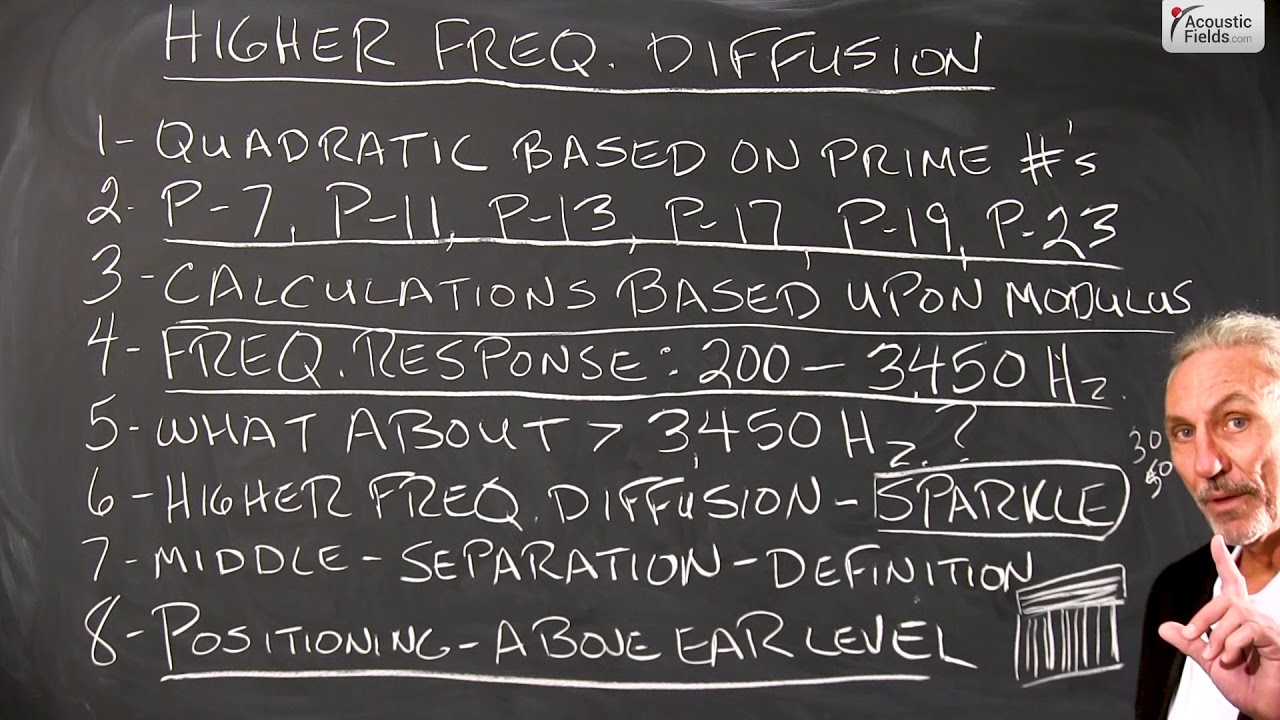Let’s talk about higher frequency diffusion. In most of our discussions we talk about vertical, horizontal, two-dimensional, one-dimensional diffusion. And that’s a diffusion that is quadratic and it’s based on some prime numbers. And we know from our math training hopefully that prime number is a number divisible by itself and one. 7, 11, 13, 17, 19, 23. Those are the 6 sequences that we use when we offer the DIY build plans form and you can buy the finished units from us also.
But the calculations are based on a formula, a modulus formula which is too complicated to go into but it’s basically a division and a subtraction with a residue and that determines the well depth. You can look that up. Just look up modulus and you’ll get some information on that.
The frequency response in most of our diffusers that we use on a regular basis averages from 200-3,450 in frequency response and we know that the well depth of the diffuser determines the low end and the well width determines the upper frequencies at which the diffusion occurs. The deeper the diffuser, the lower the frequency response.
So as a general rule, the difference between a 7, 11 and a 13 is about one octave between the 7 and 11, another octave between 11 and 13 etc, etc. So it diminishes after you get a little bit higher up in the prime numbers. But to give you an idea, a diffuser that goes down to a 100 cycles is almost 3 feet deep. Because it is based on quarter length, right? And a 100 cycle wave is 11 foot so 3 foot is about 25% of it.
But what about the frequencies above 3,450? What about those 4,000, those 5,000, those 6,000 cycle energies that give our brass instruments, our higher notes on the piano, give it that kind of spatiality and that what we call the middle and high frequency separation for the normal diffusion. But the higher frequency diffusion we can get what I’m going to call – it’s not very scientific but it’s called sparkle.
And we offer a product, it’s our many wood diffusers which are anywhere from 2-3 inches thick and made out of solid wood. And if you take them and you position, you have a whole battery – ooh, that’s a nice sound – you have a whole battery of vertical diffusers across the wall. And then you take a mini diffuser that can have a frequency response of let’s say 3,000-4,000 or even higher. And you position that above a vertical array all around the room. You can really add a lot of lightness, a lot of realism to the note. It almost makes the higher note float in space.
And we have some of that in our studio in Hollywood and we experiment. We take some diffusers down, we add some diffusers and it’s funny because you can get chimes, you can get the higher frequency notes to actually float between the speakers. And it’s very, very pleasing to hear and you can accomplish that with higher frequency diffusers.
So don’t – when you get more sophisticated in your designing and you get more sophisticated in your treatment applications in your room and you get more budget – because higher frequency diffusers are made out of solid wood, they’re very expensive. And you need quite a bit of them to cover the surface area. So get your 200-3,450, 3,450 taken care of with normal, vertical and horizontal diffusion but if you want to add a little increased diffusion, an increased sparkle to your presentation, you can look at higher frequency diffusion.
—
This is an unedited transcript from our video series from Acoustic Fields. There will be some errors in grammar and sentence structure that occur during this translation process.
For complete understanding and comprehension, please view the video which is included in this text. For any additional information regarding this topic or others relating to room acoustics, please contact us directly at:
P: 520 – 392 – 9486








These are great. I’d love your input on my listening room and any recommendations you may have. It’s a big and open room (15′ x 20′ x 10′), but not ideal otherwise due to windows behind and on the side walls parallel to my loudspeakers, and non-symmetrical open areas (e.g. a hallway running along 75% of the length of the room, and stairs going up along back side).
Chris
C, Fill out the information in this link: https://www.acousticfields.com/free-room-analysis/